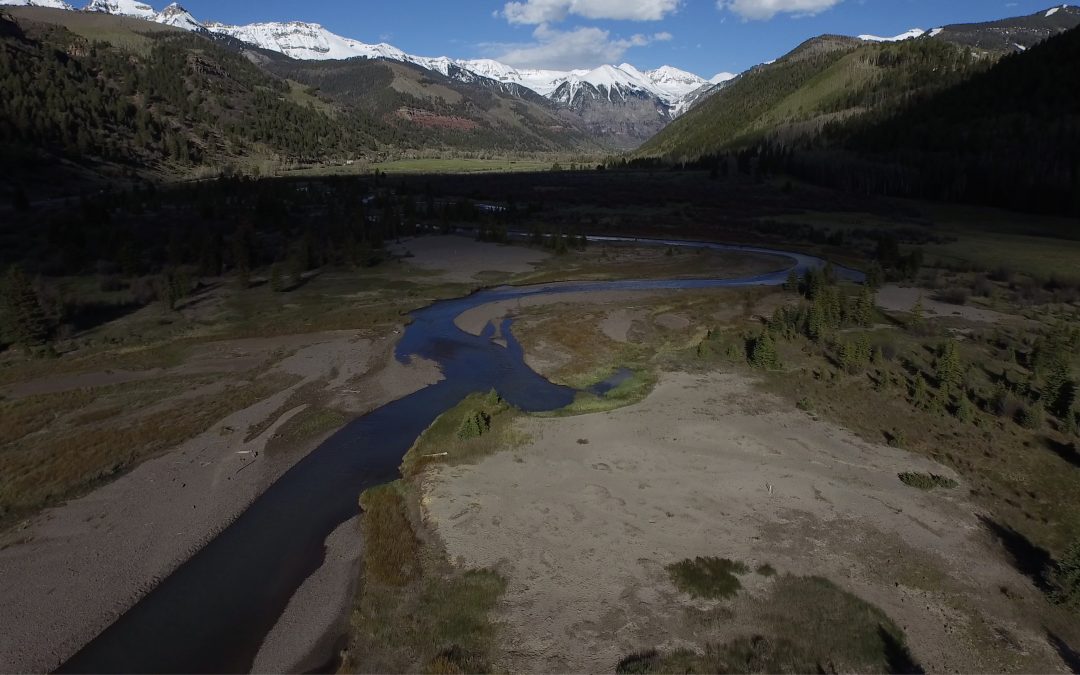If you have ever driven up the San Miguel River canyon into the high alpine peaks surrounding the Town of Telluride, you have seen the Valley Floor. Many Telluride residents consider this part of the drive a long deep breath as they arrive home. In 2008, the Town of Telluride was finally able to secure the 600-acre Valley Floor after decades of negotiating with the landowner, followed by a massive fundraising campaign. The Valley Floor is now protected by a conservation easement and zoned as Open Space in perpetuity. The property, an undeveloped landscape with mixed forests, grasslands and riparian habitat, is the headwaters flood plain of the San Miguel River which is one of the last undammed rivers in Colorado.

Placer mining on the Valley Floor. Courtesy of Denver Public Library and Valley Floor Preservation Partners
In the late 1800s and early 1900s, the Telluride community was mostly miners and their families who saw the constantly shifting river as a nuisance. It was even referred to as an “unruly dragon” in a newspaper story from that time. Eventually the river was utilized to carry the accumulating heavy metal-laden tailings from the mines, downstream where they were deposited along the banks throughout the Valley Floor.
The San Miguel River flows through the entire length of the Valley Floor and is joined by surface and groundwater flows from four headwater tributaries within the property. In 2016, the Town of Telluride partnered with Ecological Resource Consultants to restore Reach One, a severely degraded, channelized section of river, into a naturally meandering 4,275-foot section with 19 pool and riffle sequences to improve aquatic habitat. While successfully minimizing the amount of disturbance to existing natural plants and large spruce trees, it restored over 10 acres of wetland and upland habitat with replanted local, native vegetation. It also consolidated and capped three acres of tailings away from the stream channel. Although it was a significant construction project with large equipment in and around the Telluride community’s beloved Valley Floor, the project was generally embraced as an opportunity to restore a century of human disturbance and allow a naturally functioning river to work its magic on the surrounding habitat. During the project, residents and visitors watched in awe as the skillful and almost artistic equipment operators rapidly completed the project on time and on budget, while leaving very little trace. There was specific direction to minimize disturbance to resident wildlife including bears, elk, deer and beavers. The beavers did not exactly reciprocate and instead effectively interfered with construction nightly by blocking construction culverts. Curious elk tracks were often seen around the equipment in the morning. After three years of monitoring, we have watched the river actively carve, pool and flush indicating a healthy hydrologic system. We have also seen almost 77 percent native vegetation coverage on the disturbed ground and tailings remediation area. This was without irrigation during the 2018 exceptional drought conditions. With a little help from its friends, the river is now a highly effective restoration tool for the surrounding ecosystem. Watch The Meander, an 8-minute film about the Reach One project.
Starting in the spring of 2019, the town will again partner with ERC to restore the river in reaches 4, 5 and 6 and remediate a 23-acre historic tailings deposit, which was classified as a Superfund site by the State of Colorado in 2002. The river is heavily impacted in this area as it travels directly through eroding tailings and 900 feet of channelization. The intent of this restoration and remediation project is to consolidate and stabilize existing tailings, remove the river’s interaction with the tailings and create a naturally functioning river system. The project will mitigate past channelization impacts by improving the hydrology, channel morphology, and water quality. It will also remove the tailings from the flood plain and the river will again be allowed to meander naturally connected to its floodplain, which will add important flooding mitigation benefits for downstream residents. Following the successful design implementation of the Reach One project the design intent of this project is also to emulate a natural functioning, self-regulating system that is integrated with the ecological landscape in which it occurs.
This phase of the restoration and remediation work is a being done through a partnership of local organizations, the Town of Telluride, regional water organizations, and multiple state agencies. Participants and funders include the Valley Floor Preservation Partners, the Gunnison Gorge Angler Chapter of Trout Unlimited, the Town of Telluride, the Southwest Basin Roundtable, Southwest Water Conservation District, Colorado Water Conservation Board and the Colorado Attorney General’s Office (a participant due to the Consent Decree established for the Superfund site). Enthusiasm is broad for this project. It is an opportunity to repair a history of human impacts. The Open Space zoning and Town’s prioritization of preserving the environmental values of the property allow for a highly flexible design unconstrained by development and the ecology-based restoration method used by Ecological Resource Consultants to design a project that can be left alone to continue naturally-occurring restoration after initial construction is a highly effective approach for this property.
For a timeline and more about the Valley Floor, visit valleyfloor.org.


 Print
Print